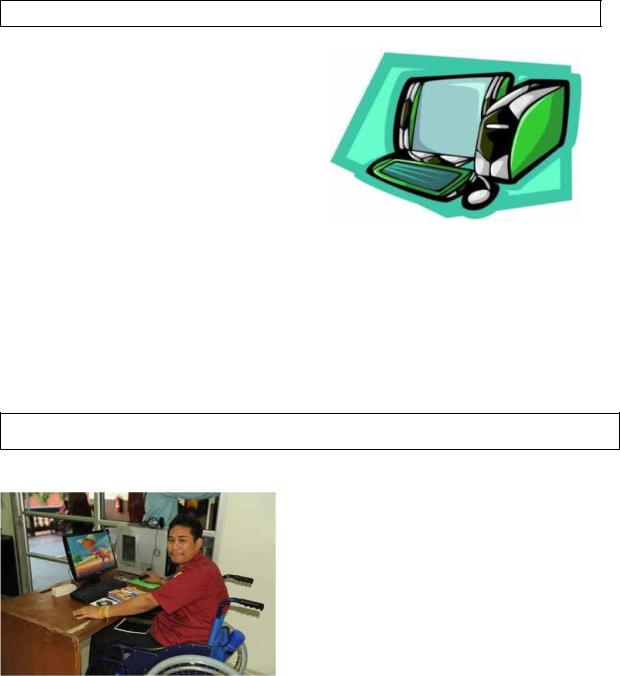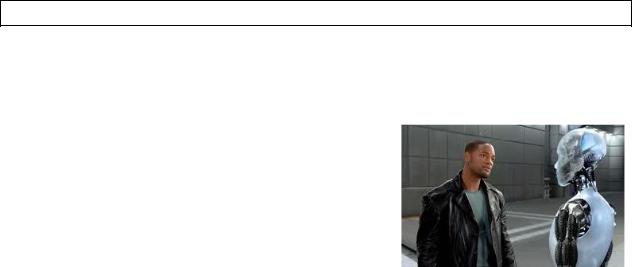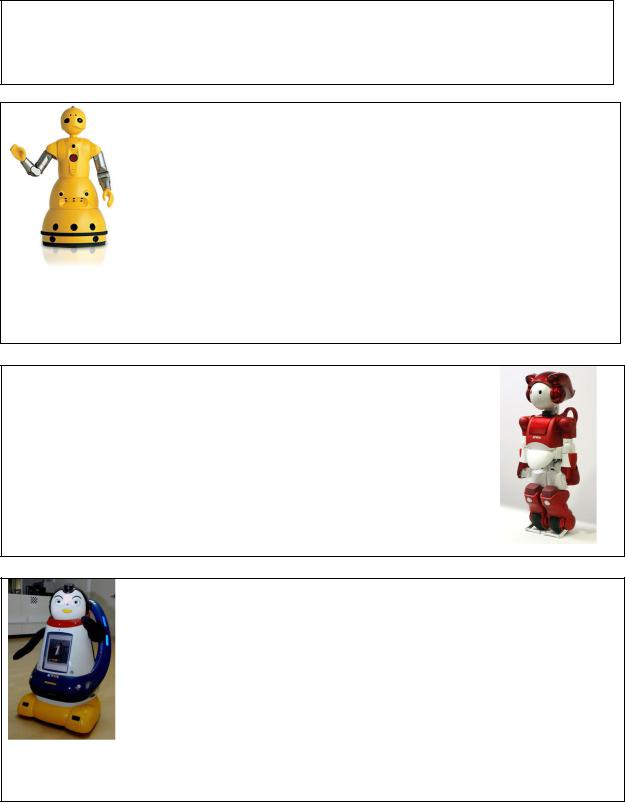
world_matters
.pdf
Unit 4
The Age of Technology
In this module you will:
Read about computers for the disabled
Talk about invention of a computerised machine
Test your project-making skills
Practise making predictions
Listen to people talking about how they use computers
Write a letter of complaint
Learn about artificial intelligence
Useful vocabulary:
Nouns |
technology, entertainment, network, icon, laptop, the disabled, |
Verbs |
bookmark, browser, favourites, link, inaction, resemblance |
to fit, to upgrade, to connect, to operate, to click on, to download, |
|
Adjectives |
to integrate, to obey, to accomplish |
interactive, virtual, wireless, computerized, adventurous, |
|
Linkers |
harmless, merciless, clumsy |
firstly, secondly, finally |
|
Phrases and |
Global Positioning System, touchscreen monitor, computer |
collocations |
addiction, cell phone, search engine, to chat online, to send emails |
42

1. Lead-in
1a People who have grown up with PCs and microchips are often called the digital generation. Read what some people answered when questioned about the use of computers in their lives.
Computers: friend …
↓
‘I have a GPS, Global Positioning System, fitted in my car. With this navigation system I never get lost. And the DVD recorder is perfect for my children’s entertainment.’
‘I use an interactive whiteboard, like a large touchscreen monitor, at school. I find computers very useful in education.’
‘Assistive technology, for people with disabilities, has helped me a lot. I can hardly see, so I use a screen reader, a program that reads aloud onscreen text, menus and icons.’
‘This new HMD, head-mounted display, allows me to watch films, and enjoy virtual reality, the artificial environment of the latest video games.’
‘The upgraded wireless network at my university is great: we can connect our laptops, PDAs and Wi-Fi cell phones to the network anywhere in the campus. Communication is becoming easier and easier.’
or foe?
↓
‘Our society has developed technological dependence. When computers are down, our way of life breaks down: planes stop flying, telephones don’t work, banks have to close.’
‘Computers produce electronic waste, plastic cases and microchips that are not biodegradable and have to be recycled or just thrown away.’
‘They are responsible for health problems, e.g. computer addiction, an inappropriate and excessive use of computers.’
‘Cybercrime, crime committed with the help of computers, is creating serious problems.’
‘Citizens may feel a loss of privacy because of unauthorized use of personal data or receiving unwanted electronic messages.’
1b Make a list of the ways your family uses computers at work and in your free time. Can you think of any problems that using computers might cause?
43

2. Listening
 2a Listen to these people talking about how they use computers at work and write each speaker’s job in the table. Track 11.
2a Listen to these people talking about how they use computers at work and write each speaker’s job in the table. Track 11.
composer |
electrical engineer |
|
secretary |
librarian |
|
Speaker |
Job |
What they use computers for |
|
|
|
1 |
|
|
2 |
|
|
3 |
|
|
4 |
|
|
 2b Listen again and write what each speaker uses their computer for.
2b Listen again and write what each speaker uses their computer for.
3. Reading
Pre-reading activities
3.a Work in pairs to answer the following questions:
1 What sort of difficulties do you think are experienced by computer users with limitations of vision or mobility?
2 What type of devices could be helpful to disabled users?
While-reading activities
3.b Match the FAQs (A-F) with the answers (1-6).
AHow can a blind person see a computer screen?
BHow can disabled people or very ill children make friends?
CWhat does a Picasso painting sound like?
DHow can you communicate with no words?
EHow can you use a computer with your mind?
FHow can disabled people become more independent?
44
Computers for the disabled
Can you hear or feel pictures? Can you move something without touching it? Dan Jellinek went to Los Angeles and found out that you can do all these things…and more.
Computers have started to change the lives of some disabled people. They can help them to communicate and to live more independently. The 14th international conference on computers and disabled people showed some exciting examples.
1.______________.
vOICe is a program that changes pictures into sounds. Different colours and shapes have different sounds. With practice, blind people can listen to the sounds and ‘see’ them by using their ears.
2.______________.
The program MouseCAT changes pictures into vibrations on the screen. Blind people can touch the screen and ‘feel’ the images. They can also use this program to speak – they write words and the computer says them.
3.______________.
Mindmouse can identify brain activity. It is like a hat. You put it around your head and operate the computer by thinking.
4.______________.
CharM is a computer system that can identify people’s emotions. In this way, people who can’t speak can communicate how they feel to other people. 5.______________.
Handy 1 is a robot arm with five different kinds of movement. It can help very disabled people do activities like eating and drinking.
6._______________.
It is often difficult for them to meet other children. DO-IT is an Internet program that helps them get help and support from other children who suffer the same problems.
Post-reading activities
3c Read the article again. Write three ways computers can help disabled people. Example: Computers can help blind people to ‘see’ using…
_______________________________________________________________
_______________________________________________________________
_______________________________________________________________
3d Work in groups and choose the most useful invention. Give your grounds.
_______________________________________________________________
_______________________________________________________________
_______________________________________________________________
45

4. Language skills
4a Write your predictions about these topics.
1 Space tourism
e.g. There will be sightseeing trips to the Moon.
Yours: _______________________________________________________
2 The Internet
e.g. Everyone will have instant access to the Internet.
Yours: _______________________________________________________
3 Health and genetics
e.g. Electronic chips will be implanted inside our bodies to detect possible illnesses.
Yours: _______________________________________________________
4 Intelligent homes
e.g. Robots will do the house work for us.
Yours: _______________________________________________________
5 Money/Holidays
e.g. Cash will disappear.
Yours: _______________________________________________________
4b Expand these predictions into full sentences.
1 In ten years’ time/a lot of people/connect their television to the telephone line
2 Portable PCs/replace/desktop PCs/in a few years’ time
3 With the help of computers/doctors/find/cure/AIDS and cancer/by the year 2010
4 By this time next year/software manufactures/make/hundreds of new programs
5 By 2020/post offices and bookshops/disappear
6 By this time next year/I/buy/handheld computer
7 By the year 2030/robots/replace/human labour in industry
5. Speaking
5a Think of a computerized machine you would like to invent. You may choose one of the machines below:
computerized fridge computerized car domestic robot computerized house
5b Draw a picture of your machine and write notes to explain how it works.
Example: computerized fridge
What it does: speaks to you, phones shops to order more milk, eggs, etc.
46

Advantages: more convenient, less work, etc.
How it works: you tell the fridge what you want, etc.
5c Work in groups. Speak about your machines, ask and answer questions about them.
Example questions:
What can you use it for? Why is it useful?
How does it work? What do you do first? What do you do next?
Has it got any disadvantages?
5d Decide which of the inventions was:
The most useful
The most imaginative
The silliest
6. Extra Activities: Artificial Intelligence
6a There are a lot of books, films, cartoons and comic books about robots, androids and cyborgs. Read the synopses of the following films. Answer the questions below.
‘I, Robot’
In 2035 humanoid robots have become common. They are considered to be absolutely safe as the Three Laws are integrated into their mind:
1.A robot may not harm a human being or, through inaction, allow a human being come to harm.
2.A robot must obey orders given to it by human being, except where such orders would conflict with the First Law.
3.А robot must protect its own existence as long as such protection does not
conflict with the First or Second Law.
NS-5s are new robots with an uplink to V.I.K.I (Virtual Interactive Kinetic Intelligence), allowing them to receive updates wirelessly. But there is a robot which greatly differs from others. Its creator has named it Sonny. The robot is unique as it can display emotions, experience dreams, keep secrets and disobey the Three Laws. Sony has been created without an uplink to V.I.K.I that is why when other robots revolt against humans and attack the, Sonny helps people destroy V.I.K.I. At the end of the film Sonny gets freedom and becomes the main character’s friend.
‘Terminator’
The terminator is a cyborg assassin. It is very strong, has no emotions and feels no pain. The robot has been sent to the past to prevent a human resistance against the machines in the year 2029. It has a mission to kill and nothing can
47

stop the Terminator to accomplish it. The robot is indistinguishable from humans as it is covered with living tissue. It has been invented by highly intelligent robots which have the aim to take over and destroy the human race. So the Terminator is very dangerous as it is programmed to kill mercilessly. Fortunately at the end of the film the robot is destroyed.
‘WALL-E‘
WALL-E is a robot which has been designed to clean up a polluted Earth. WALL-E has been performing its duties for sever centuries and after many years of prolonged activation it has evolved and become more human-like. WALL-E is fond of collecting interesting knick-knacks which it finds among the rubbish. The robot has made friends with a cockroach. It often watches an old video tape of Hello, Dolly! and learns about human emotions including love. WALL-E falls in love with another robot named EVE which is cold and indifferent at first but warms up to WALL-E a little later. Thanks to WALL-e’s brave and adventurous nature people return to Earth.
Questions
1)What are the relations between robots and humans in these films? Are clever machines people’s friends/servants/exterminators?
2)What adjectives can you choose to characterize the robots from each film (strong, funny, adventurous, powerful, dangerous, harmless, helpful, merciless, clumsy etc.)?
3)When do the robots begin to experience human feelings? Why?
4)What is the main idea of each film?
6b Read the text ‘Artificial Intelligence’ and say if machines can be as clever as humans.
Artificial Intelligence
Artificial Intelligence (AI) is invading the world. In the 90s and early 21st century AI achieved its greatest success. There are more and more jobs which humans leave to robots such as exploring another planet, defusing bombs, exploring inside a volcano or just doing boring household chores like cleaning. Computers can perform a lot of functions: they can control cars and planes, give us the news, play chess and football or compose music. Many factory jobs are performed by industrial robots nowadays. It has led to cheaper production of various goods, including automobiles and electronics. Industrial robots have little resemblance to a human being.
48

Artificial Intelligence has successfully been used in a wide range of fields including medical diagnosis, stock trading, robot control, law, scientific discovery and toys. Industrial robots are also used for packaging of manufactured goods, transporting goods around warehouses or hospitals or removing tiny electronic components with great accuracy, speed and reliability. Robots can move around, sense and manipulate their environment, predict the actions of others and exhibit intelligent behavior. Scientists are interested in designing robots that resemble a human.
Are robots our best friends or are they dangerous? It is still very difficult to answer this question. Some futurists believe that artificial Intelligence will fundamentally transform society. Ray Kurzweil has calculated that desktop computers will have had the same processing power as human brains by the year 2029, and that by 2045 artificial Intelligence will have reached a point where it is able to improve itself. Other futurists and science fiction writers have predicted that human beings and machines will merge into powerful cyborgs-humans with significant mechanical enhancements. Many people fear that highly intelligent robots may take over and destroy the human race. There are a lot of books and films about people losing control over clever machines which begin to kill their creators. But maybe it is early to worry as robots are still clumsy and not very intelligent.
But of course there are some reasons to worry about robots. The use of robots in industrial leads to unemployment as many jobs are performed by machines. Besides industrial robots can be dangerous and cause harm to human workers. So much attention must be paid to security.
There are a number of competitions and prizes to promote research in artificial Intelligence. Many large companies have created robots which can perform specific functions in the manner of a man.
ASIMO (Advanced Step in Innovative Mobility) is a humanoid robot created by Honda Motor Company. The robot is 130cm tall and weight 54 kilograms. It can walk or run on two feet at speeds up to 6 km/h. The robot can perform various functions. ASIMO can follow the movements of people with its camera, follow a person, or greet a person when he or she approaches. ASIMO can also
recognize when a person offers him a handshake and other people’s movements. The robot can sense the environment and avoids hitting people and other objects. It can respond to its name, face people when he being spoken to, and recognize sudden, unusual sounds. ASIMO is also able to respond to
49

questions, either by a brief nod, a shake of the head or a verbal answer. The robot has the ability to recognize 10 different faces. By accessing information via the Internet, ASIMO can provide news and useful information.
Wakamaru is a Japanese domestic robot made by Mitsubishi Heavy Industries. The robot has been created to provide companionship to elderly and disabled people and to make their life easier. The robot is yellow, 1 m tall, and weight 30 kilograms. Wakamaru can connect to the Internet, and has limited speech and speech recognition abilities. It can say, ‘Welcome back!’. ‘Let me search the Internet’ and other simple phrases. The functions it can perform include
reminding the user to take medicine on time, and calling for help if it suspects something is wrong. When its batteries run out, Wakamaru recharges itself.
Hitachi created its second humanoid robot EMIEW2 in 2008. EMIEW2 weight 13 kg and can move on wheels as well as two legs. The robot is 80 cm tall, a height for looking over desk tops. It has 14 microphones which enable it to recognize human voice and sounds. The robot can distinguish voices even when three people are speaking at the same time and it can recognize voices spoken as far as 2m away.
Electronics and Telecommunication Research Institute of Korea has developed a robot with four human senses such as seeing, hearing, touching and smelling. POMI (Penguin rObot for Multimodal Interaction) can move the eyebrow, eye lid, eye ball and lips. It also uses various colors to show face expressions. POMI has two kinds of built-in scent sprays to express happiness, sadness, and joy. It also has a heartbeat device which
makes people feel like the robots heart really beats up when they put the hands on the left chest of the robot, It also can talk to people through a built-in speaker.
6с Complete each sentence (A-H) with one of the endings (1-8):
A.There are more and more jobs which humans leave to robots such as
B.Computers can perform a lot of functions : they can
50
C.Artificial intelligence has successfully been used in a wide range of fields including
D.Industrial robots are also used for
E.Robots can
F.Some futurists believe that artificial intelligence will
G.Other futurists and science fiction writers predicted that
H.The use of robots in industry leads to
1.medical diagnosis, stock trading, robot control, law, scientific discovery and
toys.
2.fundamentally transform society.
3.packaging of manufactured goods, transporting goods around warehouses or hospitals or removing tiny electronic components.
4.exploring another planet, defusing bombs, exploring inside a volcano or just doing boring household chores like cleaning.
5.human being and machines will merge into powerful cyborgs.
6.control cars and planes, give us the news, play chess and football or compose music.
7.unemployment as many jobs are performed by machines
8.move around, sense and manipulate their environment, predict the action of others and exhibit intelligent behavior.
6d Give the definitions of the following words
1.Artificial intelligence
2.Robot
3.Cyborg
4.Android
5.Humanoid
6e Answer the questions
1)Why do people make robots?
2)Why do some people believe that robots can be dangerous?
3)What are the real reasons to worry about robots?
4)Are there any limits to how intelligent machines can be?
5)What is the difference between human intelligence and artificial intelligence?
6)Can a machine have human feelings? Why?
51
